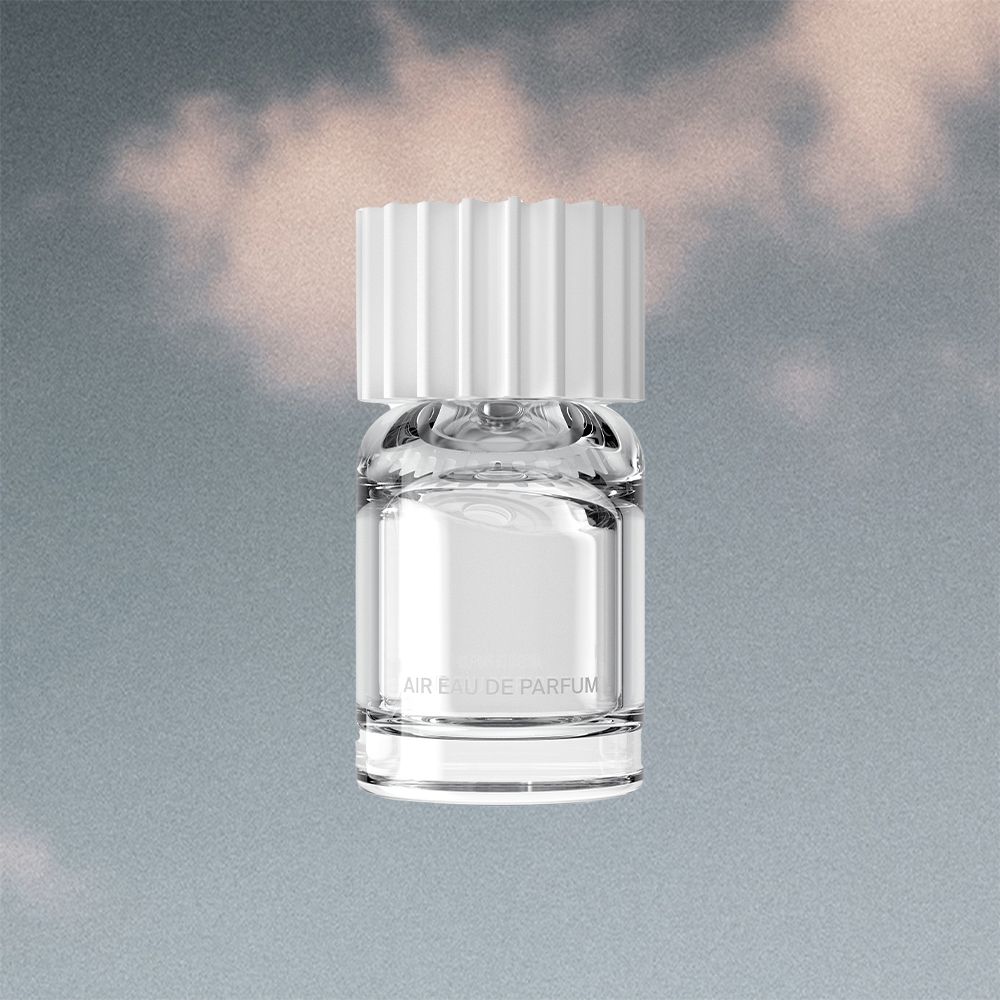A good fragrance can transfix both the wearer and those receiving a whiff of it in passing. Warm notes of amber, sweet-smelling florals, citrus, woods, and musk are just a few of the smells we gravitate to when on the hunt for our next signature scent. But a perfume made from air? Now, that’s a new one for even the most seasoned fragrance users–– and it’s exactly what Air Eau De Parfum ($220) is about.
Created with innovative technology that produces alcohols from the air, Air Eau De Parfum first debuted on the beauty scene during the tail end of 2021 with a compelling mission and intriguing formulation. Its minimalistic design and approach to fragrance are the perfect aesthetic for today’s digital culture. But its arrival begged one valid question: What exactly does air smell like?
In a conversation with Air Company and fragrance co-founder Gregory Constantine, I learned that developing a scent utilizing ethanol production technology was always his company’s goal. Having already produced hand sanitizer and vodka, Air Eau De Parfum was the next innovation for the company, but it had to be correctly executed. Constantine wanted the fragrance to be subtle yet lively, inviting, fresh, warm, and, most importantly, sustainable. I was intrigued to learn more about the world’s first-ever carbon-negative perfume, and Constantine shared all the details with me ahead.
The Story
:max_bytes(150000):strip_icc()/AirCompanyAirEaudeParfum_1-1426b27ff7324e7bad8d7ff711f85c2a.png)
:max_bytes(150000):strip_icc()/AirCompanyAirEaudeParfum_1-1426b27ff7324e7bad8d7ff711f85c2a.png)
Carbon technology company Air Company launched in 2019 with a mission to change the way we think about and fight climate-caused environmental problems. “Sustainability is our guiding principle, and our ethos lies in slowing the momentum of climate change,” Constantine explains.
Through its unique technology Air Company transforms carbon dioxide from the atmosphere into ultra-refined alcohols that can create a variety of consumer goods. So naturally, a fragrance utilizing this technique was on the horizon.
When it comes to the formulation of Air Eau de Parfum, you won’t find the use of natural essential oils frequently found in most fragrances. Instead, this genderless scent is made from synthetic scents using 100% renewable energy sources. “Our carbon conversion technology takes captured carbon dioxide and transforms it into impurity-free alcohols,” Constantine says. “From there, the alcohol is formulated with water and a variety of scents to create the final fragrance.”
But science is just one part of this unique parfum. Air Company collaborated with Brooklyn-based fragrance design firm Joya Studio to develop its signature scent to create a genderless smell that Constantine describes as fresh and expressive of the elements.
The Scent
If you’re still wondering what air smells like, you’d be surprised to learn that Air Eau de Parfum’s notes are more profound than the standard clean and crisp. “We designed this scent to smell different on everybody,” Constantine says. “So, when it came to developing the notes, it was our goal to have them be unconventional.” On the nose, you’ll find top notes of orange peel and fig leaf, with the core boasting notes of jasmine, violet, azalea, sweetwater, and its base, a powdery musky tobacco scent.
Though it is classified as a fresh fragrance, Air Eau de Parfum artfully blends fresh, woody, and floral notes. True to Air Company’s mission, the fragrance is made with synthetic scents instead of natural. This conscious decision was just one of many sustainable efforts of Air Eau de Parfum’s production, including its packaging.
“When it comes to the product design, we’ve set out to create a minimalistic, labelless bottle—reducing waste and placing focus on the core product,” Constantine says. The 50ml glass bottles come in three different cap options; high-gloss chrome, satin finish, and a no cap option for an even lighter environmental impact. The bottles are also designed to be reused once emptied.
The Mission
Packaging and ingredient sourcing aren’t the only Air Eau de Parfum elements rooted in sustainability. “In addition to the function of our technology that makes Air Eau de Parfum, our system utilizes 100% of our carbon dioxide supply, ensuring none gets re-emitted into the atmosphere,” Constantine says. “Each bottle of fragrance we create prevents 36 grams of carbon dioxide from being released into the atmosphere.”
Air Eau de Parfum marks the company’s debut in the beauty industry, but it’s only the beginning. To pave the way for significant emissions reduction, Air Company plans to scale its carbon technology across other areas of beauty, and the future looks bright. “By creating sustainable alternatives to everyday products, such as fragrance, we hope to educate consumers on both climate change and carbon technology solutions,” Constantine says. “We hope that Air Eau de Parfum will showcase how current industry practices can become carbon-negative standards and inspire the beauty industry to reevaluate their production processes.”
Bottom Line
Air Eau de Parfum hits shelves in March and is currently available for pre-order. Even though the masses haven’t gotten a whiff quite yet, it’s safe to say this futuristic fragrance deserves a spot in your collection. We expect fancy fragrance aficionados to be all over the world’s first air-based innovation, so you should probably snag your bottle now.
How to Build a Fragrance Collection, According to Perfumers










